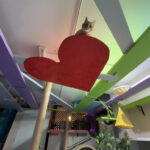Developing “Cats Are Liquid” presented a unique set of challenges and unexpected turns, many of which shaped the game into what it is today. This post delves into some key aspects of the game’s creation, from level design inspired by P.E. classes to the surprising impact of ability removal on the narrative. If you’re curious about the journey behind this quirky platformer where cats are liquid, read on.
Leveling Up: P.E. Class Inspiration
The initial concept for level design was, admittedly, a bit unconventional. Believe it or not, it stemmed from the structured, sequential nature of physical education classes. Remember those P.E. sessions where you’d move from one apparatus to another – cartwheels, rope climbs, horizontal bars? That step-by-step progression became the unexpected blueprint for the game’s levels.
Take, for example, this level structure:
 Linear level design inspired by P.E. classes in Cats are Liquid
Linear level design inspired by P.E. classes in Cats are Liquid
The design is distinctly linear. Obstacles are introduced and conquered one at a time, mirroring the stations in a P.E. class. Players rarely face multiple challenges simultaneously. Once an obstacle is overcome, it’s no longer a concern. This straightforward, linear approach, much like navigating a P.E. circuit, was a deliberate design choice in “Cats are Liquid”.
Battling Repetition: Keeping Gameplay Fresh
Early playtesting sessions, conducted with meticulous care (and the simple instruction: “You’re a cat, and you can’t touch orange things. Report any bugs.”), revealed a critical issue: the gameplay could quickly become monotonous.
The core mechanics were intentionally simple: move, jump, dodge, become liquid, repeat. However, the simplicity, while initially appealing, risked becoming tedious. The environments lacked significant variation, and while new obstacles were introduced to add complexity over time, they weren’t enough to fully combat the growing sense of repetition in this cats are liquid adventure.
To counteract this, I needed to inject elements that would sustain player engagement and prevent the game from feeling stale. This led to the development of in-game abilities.
Unleashing Abilities: Adding Layers of Gameplay
Introducing abilities or power-ups became a key strategy to enrich the gameplay experience.
Flight:
The flying ability was the first power-up implemented. Its genesis was in observing players new to platformers during playtests. The aim was to provide a mechanism to bypass particularly challenging obstacles, but with enough of a drawback to discourage overuse. The slow flight speed was a deliberate choice, theorizing that players would find the sluggish pace frustrating and opt for mastering the standard platforming mechanics instead. While certain sections were designed to necessitate flight, its primary purpose was subtly disguised.
This theory seemed sound during testing, but player reception post-release was somewhat different. Many reviews cited the flying ability as overpowered, a point I’ll revisit in a later part.
Companion:
Struggling to conceptualize another power-up, I turned to playing other games for inspiration, landing on Portal.
Upon encountering the Companion Cube in Portal, the idea clicked. A similar mechanic could be effective in “Cats are Liquid.” (Bonus imaginary internet points if you can guess the origin of the power-up’s name!)
The timer associated with the Companion was included not to increase difficulty, but to address a playtesting observation: players often forgot to reabsorb the square, leading to confusion when it was needed later. It acts as a gentle reminder of the Companion’s presence and utility, becoming particularly integral in the Companion-themed levels.
Bombs:
The bomb ability emerged from watching a Super Metroid speedrun during a Games Done Quick event. The speed and strategic destruction were inspiring, and the concept translated well to the cats are liquid world, adding an element of offensive capability.
Abilities Lost: A Screen Space Constraint
From World 7 onwards, the abilities begin to be removed, and the reason behind this is rather pragmatic: screen real estate.
Consider this screenshot from the Android version:
 Cluttered UI in Android version of Cats are Liquid, prompting ability removal
Cluttered UI in Android version of Cats are Liquid, prompting ability removal
This image, taken from World 7 Level 1 where all abilities are available, illustrates the issue. The right side of the screen is densely packed with buttons. Further additions were simply impossible. Button size was already at a minimum for comfortable play on smaller phones, and relocating buttons to the left was not feasible due to existing movement and Companion controls. The challenge became finding a way to manage interface clutter.
The solution, surprisingly, was subtraction. Instead of trying to cram more elements onto the screen, what if I started removing power-ups?
This screen space limitation inadvertently led to the ability-removal mechanic, which, unexpectedly, profoundly influenced…
The Narrative Shift: From Gameplay to Story
Even with the introduction of diverse abilities, a sense of emptiness persisted. It was then that the idea of incorporating a story resurfaced. While considered before, it hadn’t gained traction.
The approach of conveying the narrative through in-game text emerged from the realization that voice acting was not a feasible option. Text also served to enrich the levels visually, providing players with more than just an exit door to anticipate.
The story’s increasingly somber tone was largely an unintended consequence of the ability-removal concept. Contemplating how the cat character would feel as its acquired powers were systematically taken away naturally led to a darker narrative arc. By the time World 9 was in development, the question became, “Why not make the ending equally dark?” ¯_(ツ)_/¯
Nearing Completion: Addressing Lingering Issues
The addition of story and abilities significantly improved player engagement and made the game feel more complete. Playtester feedback was much more positive. Mission accomplished, or so it seemed.
However, some reviews still pointed out the game’s tendency towards repetition and the sometimes-repetitive nature of the in-room text. The irony wasn’t lost.
Audio Design: Simplicity in Sound
Music was not a primary focus during development. The soundtracks are essentially improvisational pieces using various instruments and synthesizers. The goal was to maintain simplicity in the music, mirroring the game’s straightforward design.
The music usually starts with a basic rhythm or melody, upon which layers are gradually built. The structure of most tracks is intentionally simple: a main melody introduction, instrumentation buildup, and a gradual return to the main melody.
Sound effects were initially intended to be more comprehensive, but due to a lack of interest in sound design (which persists), their implementation remained limited.
Part 3, detailing the game’s release, Steam Greenlight, and related topics, is forthcoming…

